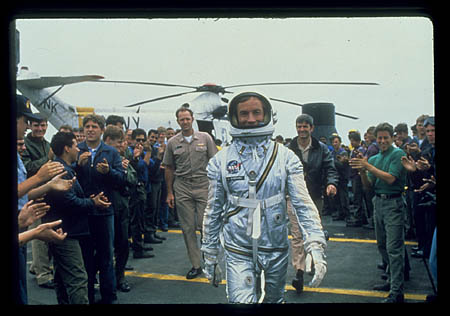
(c)1983 The Ladd Company. All.rights reserved.
“The Right Stuff” High tech = not real! The result of the efforts of the special effects staff who achieved overwhelming reality.
2020.03.28
Shooting in more open areas
This work was done on the street behind USFX. However, there was a limit to how much clear sky we could capture. So we chose a hill overlooking Candlestick Park (the baseball stadium where Hideo Nomo made his major league debut), 3.2 km from the studio, as the shooting location. The site used to be an orphanage, but it had been cleared to make way for an apartment building.
The scene shown here shows Jaeger attempting to record the altitude of the NF-104A, which was filmed in a tongue-in-cheek way by attaching a weight to the tail of a plastic model and lifting it with a helium balloon. The wires suspending the model were 15m long to keep the balloon out of the frame, and Fitcher tracked it with a telephoto lens up to an altitude of 4km.
In addition, as in the re-entry scene of Friendship 7, a wire (about 30m) was stretched diagonally from a work platform and the XS-1 and X-1A were slid down while being filmed using a dolly. A simpler method was to hang a model from a work platform and film it while it swung in a pendulum motion.

"The Right Stuff" (c) 1983 The Ladd Company. All.rights reserved.
There was also a scene where a wire was stretched horizontally, and an Estes Industries model rocket engine was attached to the nozzle of the X-1A, and the model was launched using that thrust. This time, slow-motion photography at 10 to 12 fps was used to create a sense of speed. At one point, the rocket engine suddenly exploded, blowing the rear of the model away with a burst of flames. At that moment, special effects cameraman John Fante(*12), who was filming by hand, was so surprised that he shook his camera violently. As a result, the footage had a very realistic feel to it.
What they were doing was basically the same as in the 1952 B-grade sci-fi film Radar Men from the Moon , but in the end, this method turned out to be the most realistic.
To create the effect of large cloud formations, a torpedo boat smoke screen generator was used for the filming at this location, producing a special type of smoke that could rise over 100m into the air and resemble a cumulonimbus cloud, in addition to which a large insecticide sprayer was used close to the camera to create clouds in the foreground, adding depth to the image and obscuring the presence of the wires.
What bothered them, however, were complaints from neighbors, which led to frequent patrols by police and firefighters.
*12 『Star WarsFamous for being the first ever parody ofHardware Wars'(78) cameraman.
Representation of outer space
As this realistic imagery begins to take shape, the unnaturalness of the Mercury spacecraft scene, which was shot earlier using motion control and blue screen compositing, begins to become more apparent.
Holman, who was in charge of this part, improved the sense of unity between the Earth background and the Mercury capsule by duplicating the completed composite shots by placing a gauze over the lens of the optical printer. (*13)
Holman also had a hard time expressing the Earth. Whether it was a matte painting he had done himself or a NASA photograph, simply photographing it always made it seem flat. After repeated experiments, he decided to reflect it on a 120cm diameter hemispherical mirror. The material reflected here was a retouched slide photograph of the Earth, which was photographed once while moving. This image was then rear-projected and reflected on a hemispherical mirror placed opposite it, and photographed from below (so that the camera would not be reflected in the mirror) with a camera placed between the rear screen and the mirror. This created the impression of clouds drifting across a rounded sphere.
*13 The result was a finished product that looked as if outer space had an atmosphere and was faintly hazy. Anyone who values scientific accuracy would quibble with this, but the film's depictions of satellite orbit, particularly the flight scene of Friendship 7, are so fantastical that it doesn't feel all that strange. If anything, Belson's footage of the Earth, which is spliced into this scene, stands out somewhat from the other shots. Holman said, "Belson's images were very surreal, on the border between reality and madness. But in his images, the Earth really looks alive."

